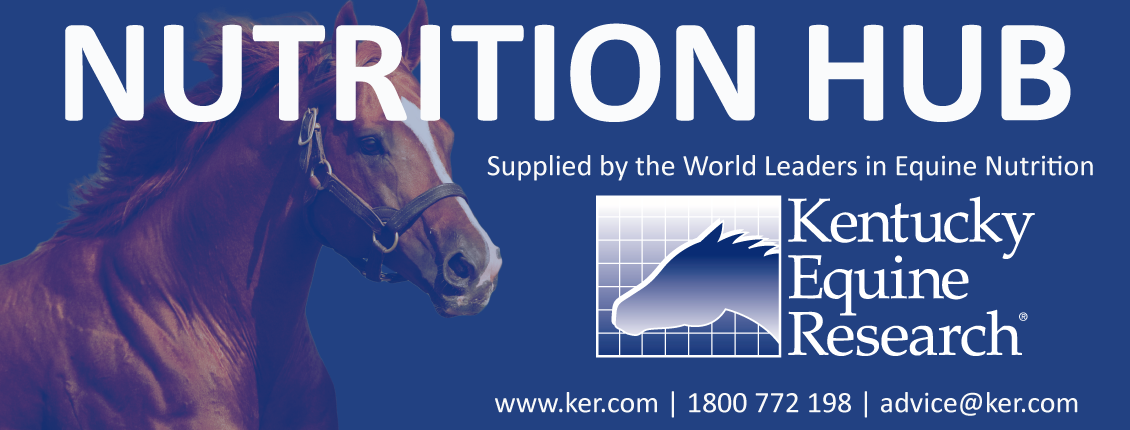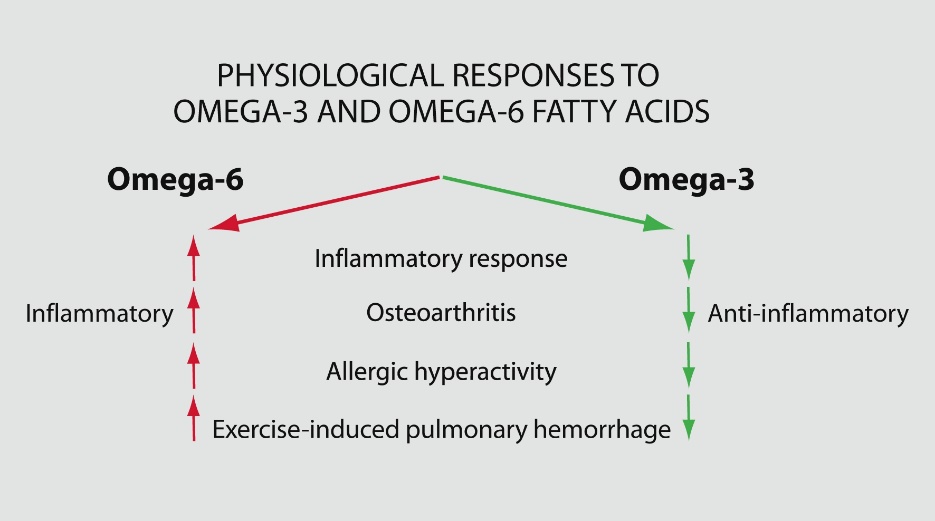
Health Benefits from Feeding Omega-3 Fatty Acids
The benefits of feeding fat as a source of energy to horses are now widely accepted. Fat is scarce in forages and is therefore a seemingly unnatural feedstuff for horses, but its nutritional advantages are now well recognised. Substitution of starch with fat can help relieve painful muscle conditions, modify behavior and help control metabolic conditions. Now that the advantages of fat are accepted almost universally by horsemen, scientists are further exploring how certain fats help horses.
Researchers have focused their attention on two distinct families of fatty acids: the omega-3 family and the omega-6 family. The omega-3 family stems from alpha-linolenic acid (ALA), and the omega-6 family originates from linoleic acid (LA). ALA and LA are considered “essential fatty acids” because they are instrumental in the life cycle, yet they cannot be manufactured in the body and must be obtained from dietary sources.
Significant members of the omega-3 family which have been shown to have a positive effect on the body are eicosapentaenoic acid (EPA) and docosahexaenoic acid (DHA). Interestingly, the horse’s body can convert ALA to EPA and DHA when insufficient quantities of ALA are consumed, although this process is not entirely efficient. ALA is found in leafy plants and commonly fed linseed oil. It is preferable to provide omega-3 fatty acids in the form of EPA and DHA as they are ready to use by the body. These fatty acids are found in fish oil. Therefore, when considering supplementing with an omega 3 supplement, it is highly beneficial to choose fish oil where EPA and DHA are already available for use in the horse’s body.
The Omega-3 to Omega-6 Ratio: A Balancing Act
Omega-3 and omega-6 fatty acids must be balanced within the body in order for both to be effective. Each fatty acid is necessary for the production and distribution of a class of hormones called prostaglandins. The prostaglandins that evolve from consumption of omega-3 and omega-6 fatty acids have different effects on inflammatory processes in the body. In addition to their effects on inflammatory responses, omega-3 and omega-6 fatty acids aid in the maintenance of cell membrane stability, development and function of central nervous system tissue, oxygen transfer and immune functions.

Scientists have not determined the optimal ratio of omega-3 to omega-6 fatty acids for horses. Even without an exact ratio, general knowledge of omega-3 and omega-6 fatty acids and typical equine management practices uncover some potentially undesirable trends.
The natural diet of horses—primarily fresh and dried forages— contains more omega-3 fatty acids than diets consisting of a mixture of forage and cereal grains or premixed concentrate feeds. Domesticated horses are often fed concentrated sources of energy in the form of grain meals. Grains and oils possess more omega-6 fatty acids than forages, creating a balance of omega-3 to omega-6 fatty acids that may be inappropriate. Horses that must expend high levels of energy— performance horses such as eventers, showjumpers, polo ponies and racehorses —are typically fed high grain and/or oil diets. Lactating broodmares and yearlings often also fit into this category. Such diets may require the addition of an omega 3 fatty acid supplement to reap the benefits of a ration high in omega-3 fatty acids.
The Benefits of Omega-3 Fatty Acids
Interest in omega-3 fatty acids has heightened among all species in recent years and equine researchers have begun to study their effectiveness in horses. Research is full of possibilities. As such, scientists are looking into other ways in which omega-3 fatty acids may benefit horses. Many studies have been undertaken by scientists to investigate the potential benefits of supplementation with omega-3 fatty acids, and promising results have come to light.
Benefits of omega-3 fatty acid supplementation for inflammation and immune function
Scientists at Texas A&M University have reported that supplementation with omega-3 fatty acids reduced joint inflammation in both yearlings and older, arthritic horses. Horses fed the omega-3 supplement had lower synovial fluid white blood cell counts than those in the control group. Raised white blood cell counts are indicative of local inflammation, and arthritic horses will typically have a much higher number of white blood cells than non-arthritic horses.
Studies conducted by the Michigan State University concluded that horses supplemented with a dietary source of EPA and DHA showed a significant increase in the plasma fatty acid profile. In this study, adding the EPA and DHA forms of omega-3 to the horse’s diet resulted in a longer trot stride length, presumably as a result of the reduced inflammation and decreased joint pain.
For horses suffering from allergies and skin conditions, omega-3 fatty acids have been shown to help with skin and coat hypersensitivity associated with insect bites and other allergic reactions.
Benefits of omega-3 fatty acid supplementation for mares and stallions
Researchers are studying the effects of omega-3 fatty acids on estrous cycles and pregnancy rates of mares, with a possible connection to reproductive function. In mares, supplementation with fish oil has led to reduced prostaglandin secretion and increased progesterone levels and this may aid embryo survival.
Nutritionists uncovered interesting results when omega-3 fatty acids were fed to pregnant mares. The mares passed along the fatty acids to their foals in their milk. These foals seemed to have a stronger immune status than foals suckling mares not fed omega-3 fatty acids.
Reproductive specialists obtained encouraging results in studies carried out on stallions - in some stallions there was a significant boost in the number of normally shaped sperm, motility after chilling or thawing frozen semen and a rise in the concentration of spermatozoa in the semen.
Benefits of omega-3 fatty acid supplementation for performance horses
The higher energy requirements of performance horses means that we often have to provide them with a hard feed in addition to the forage component of their diet. As mentioned, this means they are often provided with more omega 6 fatty acids than omega-3 fatty acids. All horses on high grain, oil or concentrate diets will benefit from the addition of a dedicated omega 3 fatty acid supplement. The addition of fish oil may also have a desirable effect on insulin sensitivity and glucose metabolism in response to exercise.
Performance horses often spend a portion of time out of the paddock and in a stable which can sometimes be a contributing factor in respiratory conditions. Approximately 15% horses are affected by recurrent airway obstruction (RAO) or inflammatory airway disease (IAD). Omega-3 fatty acid supplementation provides an additional benefit to a low dust diet in the management of horses with chronic lower airway disease. Therefore, supplementing with an EPA and DHA supplement may assist in reducing respiratory inflammation.
Omega-3 fatty acids play a role in the flexibility of cell walls. Increased flexibility of the membranes of red blood cells is crucial, especially during exercise when heart rates increase, blood thickens and packed cell volume rises. Increased elasticity of red blood cells allows easier passage through narrow blood vessels in the lungs and muscles, thereby improving blood supply and oxygen delivery. Promising results in human medicine have led researchers to explore the effects of a combined dose of DHA and EPA on reducing signs of EIPH. Scientists at Kansas State University reported a reduction of EIPH severity (bleeders) in Thoroughbreds after being fed a diet enriched with fish oil for 83 days. Other studies have reported increased red blood cell membrane fluidity during exercise in horses fed a diet enriched with DHA and EPA and this or the anti-inflammatory effect may lead to the reduced severity of EIPH.
Give Omega-3 Fatty Acids Time to Work
It is important to realize that rapidness of response to supplementation is dependent on the pathway of action. Elevated plasma levels and endocrine and cytokine actions are more rapid than enhanced semen or red blood cell characteristics. It takes around 60 days for the full spermatogenesis process to occur and the life cycle of a red blood cell is approximately 120 days. Therefore, a positive effect on bleeders requires at least 150 days of supplementation in order for DHA and EPA to be fully incorporated into all the red blood cells.
Where to Find the Omegas
Feedstuffs have varying levels of omega-3 and omega-6 fatty acids. Some may already have a place on your feed room shelves, but others may not. Here’s a quick reference list.
Rich in omega-6 fatty acids: corn oil, safflower oil, rice bran oil and sunflower oil. Corn oil is probably the most popular fat supplement offered to horses—it is affordable, palatable and readily available. Feeding one or more of these, especially in combination with a high-grain diet, may supply a horse with a surplus of omega-6 fatty acids, skewing the ratio of omega-3 to omega-6 fatty acids.
Rich in omega-3 fatty acids: fish oils (cold-water species) and linseed oil. Fish oil is a direct source of EPA and DHA. Linseed oil, on the other hand, yields ALA, which then must be converted to EPA and DHA by an enzyme that has competition for its activity. In the past, these oils were typically not as palatable as those that provide omega-6 fatty acids. However, recent studies at KER have addressed the palatability issue, in the form of a deodorized and flavored omega-3 product called EO∙3.
KERx EO∙3 is a rich source of the long chain omega-3 fatty acids EPA and DHA in a palatable liquid form. EO∙3 can be fed to all horses including foals, breeding stock and performance horses to improve the critical ratio of omega-3 to omega-6 in the diet, provide preferential precursors for production of less inflammatory local hormones and regulate gene expression to positively affect insulin sensitivity. With an omega-3 to omega-6 ratio of 12:1, feeding just 30ml of EO∙3 daily can have a positive impact on your horse’s health.
Practical Applications and Points to Remember
Omega-3 fatty acid supplementation is a smart way to offset the skewed ratio of omega-3 to omega-6 fatty acids when high-grain rations are fed to horses.
Grains and most oils contain low levels of omega-3 fatty acids, so as more cereal grains are fed the percentage of omega-3 fatty acids in the diet decreases. Positive effects on reproduction and fertility, joint health, airway inflammation and exercise-induced pulmonary hemorrhage (bleeders) have been reported after supplementation with long chain omega-3 fatty acids EPA and DHA.
Commonly supplemented fats such as corn or vegetable oils have a low omega-3 to omega-6 fatty acid ratio and therefore only compound the problem off too few omega-3 fatty acids in the diet. Linseed oil is the most widely available source of omega-3 fatty acids, but the most effective way of delivering the beneficial DHA and EPA omega-3 fatty acids is through the feeding of fish oil. It is very important to remember that you need to feed a lot more linseed oil than you do fish oil and the exact rate of conversion is unknown. Adding just 30ml of EO∙3 can have a positive impact on your horse’s health when used in conjunction with a well formulated and balanced diet.
For more information on adding omega-3 fatty acids or for help with formulating your horse’s ration, contact Kentucky Equine Research’s FREE nutrition consultation service on 1800 772 198 or email [email protected]









